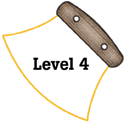
Alaska Science
Key Element B5
 |
Alaska Science |
|
Performance Standard Level 4, Ages 15–18
|
|
|
|
Sample Assessment Ideas
|
Standards Cross-References
|
||
|
National Science Education Standards Results of scientific inquiry—new knowledge and methods— emerge from different types of investigations and public communication among scientists. In communicating and defending the results of scientific inquiry, arguments must be logical and demonstrate connections between natural phenomena, investigations, and the historical body of scientific knowledge. In addition, the methods and procedures that scientists used to obtain evidence must be clearly reported to enhance opportunities for further investigation. (Page 176) Scientists have ethical traditions. Scientists value peer review, truthful reporting about the methods and outcomes of investigations, and making public the results of work. Violations of such norms do occur, but scientists responsible for such violations are censured by their peers. (Page 200) |
Benchmarks Scientists in any one research group tend to see things alike, so even groups of scientists may have trouble being entirely objective about their methods and findings. For that reason, scientific teams are expected to seek out the possible sources of bias in the design of their investigations and in their data analysis. Checking each other’s results and explanations helps, but that is no guarantee against bias. (Page 13) Current ethics in science hold that research involving human subjects may be conducted only with the informed consent of the subjects, even if this constraint limits some kinds of potentially important research or influences the results. When it comes to participation in research that could pose risks to society, most scientists believe that a decision to participate or not is a matter of personal ethics rather than professional ethics. (Page 19) Scientists can bring information, insights, and analytical skills to bear on matters of public concern. Acting in their areas of expertise, scientists can help people understand the likely causes of events and estimate their possible effects. Outside their areas of expertise, however, scientists should enjoy no special credibility. And where their own personal, institutional, or community interests are at stake, scientists as a group can be expected to be no less biased than other groups are about their perceived interests. (Page 19) Notice and criticize arguments based on the faulty, incomplete, or misleading use of numbers, such as in instances when (1) average results are reported, but not the amount of variation around the average, (2) a percentage or fraction is given, but not the total sample size (as in “9 out of 10 dentists recommend . . . ”), (3) absolute and proportional quantities are mixed (as in “3,400 more robberies in our city last year, whereas other cities had an increase of less than 1%), or (4) results are reported with overstated precision (as in representing 13 out of 19 students as 68.42%). (Page 300) Check graphs to see that they do not misrepresent results by using inappropriate scales or by failing to specify the axes clearly. (Page 300) Insist that the critical assumptions behind any line of reasoning be made explicit so that the validity of the position being taken, whether one’s own or that of others, can be judged. (Page 300) |
|
Table of Contents | Return to Alaska Native Knowledge Network